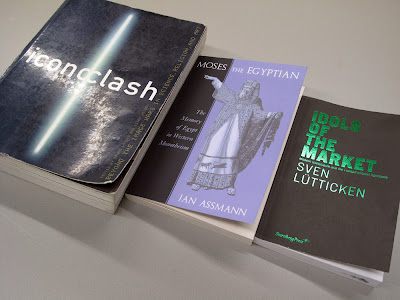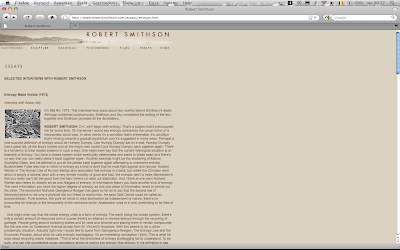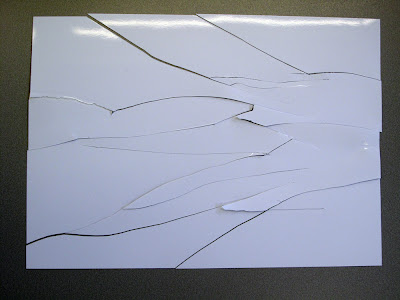Thursday 16 December 2010
Why do images trigger so much passion?
"Freud is perfectly right in insisting on the fact that we are dealing in Egypt with the first counter-religion in the history of humanity. It is here that, for the first time, the distinction has been made (by Akhenaton) that has triggered the hate of those excluded by it. It is since this distinction that hatred exists in the world and the only way to go beyond is to go back to its origins." (Jan Assmann, Moses the Egyptian)
Bruno Latour : What we propose here in this catalogue "Iconoclash, beyond the image wars in science, religion, and art" is an archeology of hatred and fanatism.
Why ?
Because we are digging for the origin of an absolute - not a relative - distinction between truth and falsity, between a pure world, absolutely emptied of human-made intermediaries and a disgusting world composed of impure but fascinating human-made mediators.
"If only, some say, we could do without any images. How so much better, purer, faster our access to God, to Nature, to Truth, to Science could be." To which other voices answer :
"Alas, we cannot do without images, intermediaries, mediators of all shapes and forms, because this is the only way to access God, Nature, Truth and Science."
("La vérité est image mais il n'y a pas d'image de la vérité." Marie-José Mondzain)
What has happened that has made images the focus of so much passion? To the point that destroying them, erasing them, defacing them, has been taken as the ultimate touchstone to prove the validity of one's faith, of one's science, of one's critical acumen, of one's artistic creativity?
Furthermore, why is it that all those destroyers of images, those "theoclasts" those iconoclasts, those "ideoclasts" have also generated such a fabulous population of new images, fresh icons, rejuvenated mediators: greater flows of media, more powerful ideas, stronger idols?
And what has happened to explain that after every icono-crises infinite care is taken to reassemble the smashed statues, to save the fragments, to protect the debris? As if it was always necessary to apologize for the destruction of so much beauty, so much horror; as if one was suddenly uncertain about the role and cause of destruction that, before, seemed so urgent, so indispensable; as if the destroyer had suddenly realized that something else had been destroyed by mistake, something for which atonement was now overdue.
Why have images attracted so much hatred?
Why do they always return again, no matter how strongly one wants to get rid of them?
How is it possible to go beyond this cycle of fascination, repulsion, destruction, atonement, that is generated by the forbidden-image worship?
(Bruno Latour, Peter Weibel : "Iconoclash, beyond the image wars in science, religion, and art")
Labels:
bruno latour,
iconoclasm
Tuesday 14 December 2010
books
Three books to study :
Iconoclash, beyond the image wars in science, religion, and art
Edited by Bruno Latour and Peter Weibel
2002 ZKM, Karlsruhe
Moses the Egyptian
The memory of Egypt in Western Monotheism
Jan Assmann
1997, Harvard University Press
Idols of the Market
Modern Iconoclasm and the Fundamentalist Spectacle
Sven Lütticken
2009, Sternberg Press
 |
| Imi Knoebel, 30 stretchers, 1968 - 1969 |
Labels:
books,
bruno latour,
iconoclash,
jan assmann,
peter weibel,
sven lütticken
Friday 10 December 2010
selfportrait iconoclasm
Is it possible to commit iconoclasm on a selfportrait?
Yes, it is possible to commit iconoclasm on a photographic portrait of myself.
Images don't cry, nor laugh.
Because of a crises in image representation artists are restless seeking for expressing their selves in not known ways. The crises of image representation is going to help artists in an interesting necessity to destroy figurative images. Figurative images have to destroy abstract pictures.
Iconoclasm is the future !
Labels:
iconoclasm,
photo
Thursday 9 December 2010
iconoclasm II
The idea for a ban on images, how and why is it born?
In the ten commandments, inscripted on two stone tablets which God wrote with his finger and delivered by Moses, it is on a very important second place :
I am the Lord your God, who brought you up out of the land of Egypt, out of the house of slavery;
1 : Do not have any other gods before me.
2 : You shall not make for yourself an idol, whether in the form of anything that is in heaven above, or that is on the earth beneath, or that is in the water under the earth.
3 : You shall not bow down to them or worship them; for I the Lord your God am a jealous God, punishing children for the iniquity of parents, to the third and the fourth generation of those who reject me, but showing steadfast love to the thousandth generation of those who love me and keep my commandments.
Because images can be powerful and therefore dangerous?
People are simple and scared and therefore they like to worship an image, of a golden calf for example. Is it that bad? God is a jealous god and that is very human quality. He or she or it has no form, god is fire, or light, sound, clouds, thunder and lightning.
Why is that jealous god so afraid of image making?
Abstract or figurative images are they equal from power?
The most powerful images are pornographic images?
"The more power pictures have, the less we seem to know about how they operate"
(Peter Weibel in Iconoclash).
To combat the figurative image, you must first acknowledge, admire and confess the figurative image?
Idolatry and iconoclasm are finally dealing with the pornographic image?
Powerful images in the vast flood of images today are images of what? Of sex, of violence, of war, of death?
Images don't cry...
Labels:
barnet newman,
iconoclasm,
idolatry,
jeff koons,
michelangelo,
ten commandments
Wednesday 24 November 2010
iconoclasm
Iconoclasm
(From Wikipedia, the free encyclopedia)
Iconoclasm is the deliberate destruction within a culture of the culture's own religious icons and other symbols or monuments, usually for religious or political motives. It is a frequent component of major domestic political or religious changes. It is thus generally distinguished from the destruction by one culture of the images of another, for example by the Spanish in their American conquests. The term does not generally encompass the specific destruction of images of a ruler after his death or overthrow (damnatio memoriae), for example Akhenaten in Ancient Egypt.
People who engage in or support iconoclasm are called iconoclasts, a term that has come to be applied figuratively to any person who breaks or disdains established dogmata or conventions. Conversely, people who revere or venerate religious images are (by iconoclasts) called iconolaters. In a Byzantine context they are known as iconodules, or iconophiles.
Iconoclasm may be carried out by people of a different religion, but is often the result of sectarian disputes between factions of the same religion. The two Byzantine outbreaks during the 8th and 9th centuries were unusual in that the use of images was the main issue in the dispute, rather than a by-product of wider concerns. In Christianity, iconoclasm has generally been motivated by a literal interpretation of the Ten Commandments, which forbid the making and worshipping of "graven images", though the topic of Biblical law in Christianity has always been in dispute.

Five printed self portraits on Epson Premium Glossy photo paper, format A3+ = 32,9 x 48,3 cm.
(From Wikipedia, the free encyclopedia)
Iconoclasm is the deliberate destruction within a culture of the culture's own religious icons and other symbols or monuments, usually for religious or political motives. It is a frequent component of major domestic political or religious changes. It is thus generally distinguished from the destruction by one culture of the images of another, for example by the Spanish in their American conquests. The term does not generally encompass the specific destruction of images of a ruler after his death or overthrow (damnatio memoriae), for example Akhenaten in Ancient Egypt.
People who engage in or support iconoclasm are called iconoclasts, a term that has come to be applied figuratively to any person who breaks or disdains established dogmata or conventions. Conversely, people who revere or venerate religious images are (by iconoclasts) called iconolaters. In a Byzantine context they are known as iconodules, or iconophiles.
Iconoclasm may be carried out by people of a different religion, but is often the result of sectarian disputes between factions of the same religion. The two Byzantine outbreaks during the 8th and 9th centuries were unusual in that the use of images was the main issue in the dispute, rather than a by-product of wider concerns. In Christianity, iconoclasm has generally been motivated by a literal interpretation of the Ten Commandments, which forbid the making and worshipping of "graven images", though the topic of Biblical law in Christianity has always been in dispute.

Five printed self portraits on Epson Premium Glossy photo paper, format A3+ = 32,9 x 48,3 cm.
Labels:
cutting and stabbing,
iconoclasm,
photo,
to destruct
Tuesday 23 November 2010
some photo's of the research proces

A photo of a geometrical ornament in the Pergamon Museum in Berlin was the exemple for the drawings shown here below. The photo is printed on an A3+ format sheet of Epson Premium Glossy photo paper.

The same photo after sandpapering it, after stabbing it and cutting it. A ghost of the image remains.
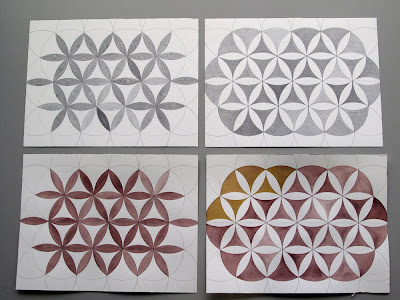
Four drawings of the Pergamon ornament. Two drawings with pencil on paper and two drawings with watercolours. On 300 grams of Arches paper with a format of 31 x 41 cm.

The same four drawings after, on the top left, erasing it with an eraser.
On the top right the drawing is vanished by sandpapering it.
On the bottom left the watercolour drawing is stabbed with an awl and screwdriver.
On the bottom right the watercolour is cut into pieces.
The destructive actions to photo and drawings is filmed. Soon it will be edited and posted here and on You Tube.
Labels:
awl,
creative destruction,
cutting and stabbing,
drawings,
photo,
surface,
to create,
to destruct
Friday 12 November 2010
four created drawings to destruct
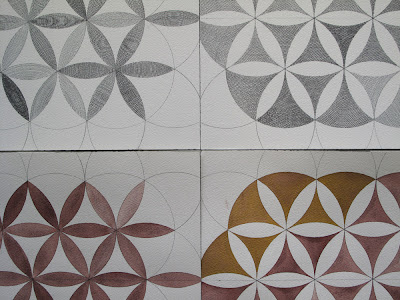
Two pencil drawings and two watercolours of the same pattern are almost finished. Within two weeks the destruction of those four drawings is going to happen. It will be documented by filming it.
Labels:
construction,
drawings,
symmetry
Tuesday 9 November 2010
Wednesday 27 October 2010
Wednesday 20 October 2010
smart & stupid

Creation & Destruction =
Apollonian & Dionysian
Good & Bad
Smart & Stupid
Order & Chaos
Civilisation & Barbarism
Love & Hate
Compassion & Aggression
Beauty & Ugliness
Labels:
creation and destruction,
creative destruction,
film
Thursday 7 October 2010
first three destructions

Three small surfaces for paintings (linen on stretchers) from about 30 x 50 cm are mutilated with sandpaper, with a cutter and with an awl. The action, or performance of destroying itself is filmed. Soon, within two weeks, the editing will be done and the film will be shown here.
Labels:
film,
linen,
photo,
to destruct
Tuesday 5 October 2010
Monday 4 October 2010
white & black
Painting a white sheet of paper with Ivory Black watercolour paint is adding paint which changes the white surface into spotty black. Can it be seen as a destruction of the original white? Or is it a change of a white surface into a black surface? It is difficult to see it as a destructive act, it is transformation in stead of destruction. Because there is no violence or aggression in painting the white surface black?
Labels:
animation
surface research plan 2010 - 2011 # 6
The “creation & destruction” research at the Rietveld Academie
How to make the “creation & destruction” artistic research meaningful for students?
I will start by giving a short lecture on the new research project for the coordinators. With their help and in consultation with the departmental teachers I would like to find a small number of students who may be interested in the research question. I hope to find these students by presenting my research subject and the possible research questions to the interested departments. The students who want to participate will not be expected to function as research assistants. The idea is for them to set up an Artistic Research of their own based on the same subject and with a few specific research questions. Holding regular meetings in which experiences or developments are presented to the research group can lead to the exchange of ideas, materials, concepts, new research questions and relevant literature. It might develop into a collaboration of researchers each studying a different section. Each one is researching a part of the complete picture to be formed later.
How to make the “creation & destruction” artistic research meaningful for students?
I will start by giving a short lecture on the new research project for the coordinators. With their help and in consultation with the departmental teachers I would like to find a small number of students who may be interested in the research question. I hope to find these students by presenting my research subject and the possible research questions to the interested departments. The students who want to participate will not be expected to function as research assistants. The idea is for them to set up an Artistic Research of their own based on the same subject and with a few specific research questions. Holding regular meetings in which experiences or developments are presented to the research group can lead to the exchange of ideas, materials, concepts, new research questions and relevant literature. It might develop into a collaboration of researchers each studying a different section. Each one is researching a part of the complete picture to be formed later.
Labels:
srp 2010 - 2011
Friday 24 September 2010
surface research plan 2010 - 2011 # 5
Research questions:
The destruction of the plain paper is the creation of another, new surface to draw on, how far can the destruction be taken while maintaining a surface which can be ‘refined’ into a drawing?
Is inflicting acts of destruction on plain paper/linen not iconoclasm? Is the destruction of figurative drawings iconoclasm? Can the phenomenon of iconoclasm be executed again and how?
Can the mutilation, and ultimately the destruction, of personally drawn figurative images be carried out with different motives? Motivated by iconoclasm, motivated by fetishism?
Does the destruction of the drawing change its symbolical, financial or emotional value? The patina of destruction?
Creating = destroying? Destroying = creating?
Can you make drawings with the frenzy, vitality, aggression and negativity inherent to (total) destruction rather than with the deliberate, investigative, presuming, expectant and positive inventiveness inherent to creating?
Destruction on surfaces is two dimensional, what is the difference in destructing three dimensional objects?
The destruction of the plain paper is the creation of another, new surface to draw on, how far can the destruction be taken while maintaining a surface which can be ‘refined’ into a drawing?
Is inflicting acts of destruction on plain paper/linen not iconoclasm? Is the destruction of figurative drawings iconoclasm? Can the phenomenon of iconoclasm be executed again and how?
Can the mutilation, and ultimately the destruction, of personally drawn figurative images be carried out with different motives? Motivated by iconoclasm, motivated by fetishism?
Does the destruction of the drawing change its symbolical, financial or emotional value? The patina of destruction?
Creating = destroying? Destroying = creating?
Can you make drawings with the frenzy, vitality, aggression and negativity inherent to (total) destruction rather than with the deliberate, investigative, presuming, expectant and positive inventiveness inherent to creating?
Destruction on surfaces is two dimensional, what is the difference in destructing three dimensional objects?
Labels:
srp 2010 - 2011
Thursday 23 September 2010
surface research plan 2010 - 2011 # 4
How will I research this?
For the practical realisation of the “creation & destruction” research I would like to follow a methodical research line in a laboratory. I will work with sheets of 300 grams Arches watercolour paper and with mounted linen with more or less the same dimensions of 30 x 40 cm. Using a long tables where I can place several of these duos, I will apply the different stages and methods of destruction on each original, empty monochrome white paper and linen surface. The destruction can be done using rough sandpaper or an awl, by carving and scraping with a cutter or by working the paper and linen with an ordinary hammer or lump hammer, a stone or a stick. Or by piercing the paper and linen with arrows shot from a bow, with bullets from a gun, pellets from a shotgun … Or by simply tearing it…
For the practical realisation of the “creation & destruction” research I would like to follow a methodical research line in a laboratory. I will work with sheets of 300 grams Arches watercolour paper and with mounted linen with more or less the same dimensions of 30 x 40 cm. Using a long tables where I can place several of these duos, I will apply the different stages and methods of destruction on each original, empty monochrome white paper and linen surface. The destruction can be done using rough sandpaper or an awl, by carving and scraping with a cutter or by working the paper and linen with an ordinary hammer or lump hammer, a stone or a stick. Or by piercing the paper and linen with arrows shot from a bow, with bullets from a gun, pellets from a shotgun … Or by simply tearing it…
Labels:
srp 2010 - 2011
Wednesday 22 September 2010
surface research plan 2010 - 2011 # 3
Why do I wish to research this?
Because the stages of development in creating are linked to a strong feeling, an intuitive conviction that says that in order to make you must dare to break.
At an early stage in my visual work, I wanted to perforate the linen or paper surface so that through the surface the other side, the back, the dead side of the surface, the opposite of the sublime was involved and made palpable. This made it necessary to open the closed and smooth front surface by an act of destruction. I did this by using hollow punches, sandpaper, an awl or a sharp knife. It is obvious that creating something means destroying the former, earlier state of the art work. We experience creating as a positive act, it means adding, changing, transforming into a final work that is a success or a failure. Creating, making, producing is progress, it is a positive path of change, adding and evolution. We do not see it as a digressive course of damaging, mutilating and the destruction of the various interim stages of development of an art work.
I do not wish to show the destructive annihilation – this would be a construction – but I wish to execute the destructive action on a surface myself. So that I can see and experience whether the apparent contradiction “creation and destruction” is a contradiction.
Because the stages of development in creating are linked to a strong feeling, an intuitive conviction that says that in order to make you must dare to break.
At an early stage in my visual work, I wanted to perforate the linen or paper surface so that through the surface the other side, the back, the dead side of the surface, the opposite of the sublime was involved and made palpable. This made it necessary to open the closed and smooth front surface by an act of destruction. I did this by using hollow punches, sandpaper, an awl or a sharp knife. It is obvious that creating something means destroying the former, earlier state of the art work. We experience creating as a positive act, it means adding, changing, transforming into a final work that is a success or a failure. Creating, making, producing is progress, it is a positive path of change, adding and evolution. We do not see it as a digressive course of damaging, mutilating and the destruction of the various interim stages of development of an art work.
I do not wish to show the destructive annihilation – this would be a construction – but I wish to execute the destructive action on a surface myself. So that I can see and experience whether the apparent contradiction “creation and destruction” is a contradiction.
Labels:
srp 2010 - 2011
Tuesday 21 September 2010
surface research plan 2010 - 2011 # 2
What is the objective?
Could the art of destruction ultimately result in the destruction of art? To overcome the act of creating appears most radical and at first glance certainly not something to strive for. However, proposing this as the ultimate consequence clarifies the aim of the study.
This leads to a critical evaluation of my art production and to the fundamental questioning of the reasons that underlie this urge and immediacy for wanting to create.
Could the art of destruction ultimately result in the destruction of art? To overcome the act of creating appears most radical and at first glance certainly not something to strive for. However, proposing this as the ultimate consequence clarifies the aim of the study.
This leads to a critical evaluation of my art production and to the fundamental questioning of the reasons that underlie this urge and immediacy for wanting to create.
Labels:
alphabet,
rietveld academy,
srp 2010 - 2011,
studio
surface research plan 2010 - 2011 # 1
What do I want to research?
What meaning do the regressive act of destruction, annihilation and breaking have in the progressive process of creating, constructing and making?
By including destructive acts in the process of creating I would like to study whether the contradiction of “creation and destruction” in reality represents one and the same principle.
Is the desire to destroy one of the conditions needed to create something as yet unknown?
What meaning do the regressive act of destruction, annihilation and breaking have in the progressive process of creating, constructing and making?
By including destructive acts in the process of creating I would like to study whether the contradiction of “creation and destruction” in reality represents one and the same principle.
Is the desire to destroy one of the conditions needed to create something as yet unknown?
Labels:
srp 2010 - 2011
Friday 10 September 2010
Thursday 9 September 2010
Wednesday 8 September 2010
jean-pierre raynaud

The French artist Jean-Pierre Raynaud turned to the systematic use of white tiles and covered his own house in La Celle-Saint-Cloud with them. The house was open to the public from 1971 to 1988 and it became a kind of monument.

The hygienic and purist connotations of the material were enriched by Raynaud's realisation of stained glass.

In 1993 the artist had his house demolished...

and presented the debris in 976 surgical containers.
He related the decision to destroy his gesamtkunstwerk to his fear of degradation, his lack of confidence in society for taking care of it after his death, and his feeling that it had reached a state of perfection beyond which every gesture would represent a profanation.
He replied to a question from the architect Jean Nouvel that one had the right to destroy a work of art if it resulted in creating another one.
Tuesday 7 September 2010
joseph schumpeter
The opening up of new markets and the organizational development from the craft shop and factory to such concerns as US Steel illustrate the process of industrial mutation that incessantly revolutionizes the economic structure from within, incessantly destroying the old one, incessantly creating a new one ... [The process] must be seen in its role in the perennial gale of creative destruction; it cannot be understood on the hypothesis that there is a perennial lull.
Joseph Schumpeter, The Process of Creative Destruction, 1942
Joseph Schumpeter, The Process of Creative Destruction, 1942
Labels:
creative destruction,
joseph schumpeter
thought
We are driven forward, whipped forward by life in order to act. War and art are the result of it.
Labels:
creation and destruction
Monday 16 August 2010
tools for creation & destruction

On Tuesday September 7 I am going to continue the Surface Research project at the Rietveld Academie in Amsterdam. It is going to be a start for a new artistic research chapter about creation and destruction. From September 7 it is possible to read more about it on this blog.
Labels:
creation and destruction
Tuesday 29 June 2010
gustav metzger

Gustav Metzger (1926)
Auto-Destructive Art [1959]
Auto-destructive art is primarily a form of public art for industrial societies.
Self-destructive painting, sculpture and construction is a total unity of idea, site, form, colour, method, and timing of the dis-integrative process.
Auto-destructive art can be created with natural forces, traditional art techniques and technological techniques.
The amplified sound of the auto-destructive process can be an element of the total conception.
The artist may collaborate with scientists, engineers.
Self-destructive art can be machine produced and factory assembled.
Auto-destructive paintings, sculptures and constructions have a life time varying from a few moments to twenty years. When the dis-integrative process is complete the work is to be removed from the site and scrapped.
Manifesto Auto-Destructive Art [1960]
Man in Regent Street is auto-destructive.
Rockets, nuclear weapons, are auto-destructive.
Auto-destructive art.
The drop drop dropping of HH bombs.
Not interested in ruins, (the picturesque)
Auto-destructive art re-enacts the obsession with destruction, the pummelling to which individuals and masses are subjected.
Auto-destructive art mirrors the compulsive perfectionism of arms manufacture - polishing to destruction point.
Auto-destructive art is the transformation of technology into public art. The immense productive capacity, the chaos of capitalism and of Soviet communism, the co-existence of surplus and starvation; the increasing stock-piling of nuclear weapons - more than enough to destroy technological societies; the dis-integrative effect of machinery and of life in vast built-up areas on the person,...
Auto-destructive art is art which contains within itself an agent which automatically leads to its destruction within a period of time not to exceed twenty years. Other forms of auto-destructive art involve manual manipulation. There are forms of auto-destructive art where the artist has a tight control over the nature and timing of the dis-integrative process, and there are other forms where the artist's control is slight.
Materials and techniques used in creating auto-destructive art include: Acid, Adhesives, Ballistics, Canvas, Clay, Combustion, Compression, Concrete, Corrosion, Cybernetics, Drop, Elasticity, Electricity, Electrolysis, Feed-Back, Glass, Heat, Human Energy, Ice, Jet, Light, Load, Mass-production, Metal, Motion Picture, Natural Forces, Nuclear Energy, Paint, Paper, Photography, Plaster, Plastics, Pressure, Radiation, Sand, Solar Energy, Sound, Steam, Stress, Terra-cotta, Vibration, Water, Welding, Wire, Wood.
Labels:
gustav metzger,
inspirations
Friday 11 June 2010
erased de kooning drawing

In 1953 Robert Rauschenberg was asking Willem de Kooning (21 years older), whom he regarded as "the most important artist of his time", to let him erase one of his drawings.
In order to use the eraser "as a drawing tool", however, he renounced resorting to one of his own drawings because the erased work "would return to nothing", and decided that he needed a drawing already recognized as art. De Kooning gave him a drawing "important enough for him to miss, and one that was difficult to erase". Rauschenberg needed four weeks of hard work to remove all but a few traces. He hand-lettered the title Erased de Kooning Drawing, 1953 on a passe-partout, added his name and the date, and placed the sheet in a gold-leaf frame.
The insistence on the dating and the museum-like labelling and framing further turned it into a monument to the appropriation and outdoing of a stage of art.
Quite recent iconoclasm is this action by Rauschenberg, and an inspiration for the continuation of my surface research project in september.
Labels:
de kooning,
drawings,
iconoclasm,
inspirations,
rauschenberg
Thursday 3 June 2010
surface research continuation


Web-master Rietje from the Rietveld Academie posted the film about drawing and erasing the eighth palimpsest on Vimeo:
Surface Research by Henri Jacobs.
The Surface Research project is probably going to continue next year. Currently I am writing a text about the continuation of the project. Foreseeing a series of drawings on creation and destruction. Systematically executed on three different sorts of paper, and each paper-sort will get it's specific drawing material. Epson photo paper is going to be drawn with ink, 200 grams drawing paper is going to be drawn with pencil and 500 grams watercolour paper is going to be drawn with aquarelle paint. Drawing has to happen to create "value" that can be destroyed.
Soon, when the text about the continuation of the project is ready, it will be posted on this weblog.
I imagine that filming the creation and destruction process will be the best way of documenting this new Surface Research chapter.
A bientôt...
Labels:
creation and destruction,
film,
rietveld academy
Tuesday 1 June 2010
Monday 31 May 2010
womb & tomb

On the top left : Mother Kali,
Hindu goddess from India,
womb and tomb,
she creates and destroys worlds,
female, black, time,
standing on the body of Shiva.
Kali, Tara, Shodashi, Bhuvaneshvari, Bhairavi,
Chhinnamasta, Dhumavati, Bagalamukhi, Matangi, and Kamala.
Labels:
to create,
to destruct
Friday 28 May 2010
order & chaos

Two journal-drawings from July 2008.
The first line drawn on a white sheet of paper damages, attacks and destroys the white paper.
The paper destroyed the tree.
Creating is destroying, bluntly said.
Every construction is damaging the earlier state.
Making and creating is in the same time damaging and destroying. This is a conclusion after one year of Surface Research.
Surface Research Results Exhibition # 2
Monday May 31 2010 / 12:00 - 19:00 h
Tuesday June 1 2010 / 17:00 - 21:00 h
Wednesday June 2 2010 / 12:00 - 19:00 h
Thursday June 3 2010 / 9:00 - 14:00 h
Pavilion Gerrit Rietveld Academie
Fred Roeskestraat 96
1076 ED Amsterdam
Labels:
surface research results,
to create,
to destruct
Thursday 27 May 2010
exhibition pavilion

To create exhibition walls for drawings in the Rietveld Pavilion, which is from glass and one brick wall, I made a sketch to build 7 panels in the Pavilion. It is already build, therefore "l'acrochage des oeuvres" is the next step.
Come and see, next week, INVITATION :
Surface Research Results Exhibition # 2
Monday May 31 2010 / 12:00 - 19:00 h
Tuesday June 1 2010 / 17:00 - 21:00 h
Wednesday June 2 2010 / 12:00 - 19:00 h
Thursday June 3 2010 / 9:00 - 14:00 h
Pavilion Gerrit Rietveld Academie
Fred Roeskestraat 96
1076 ED Amsterdam
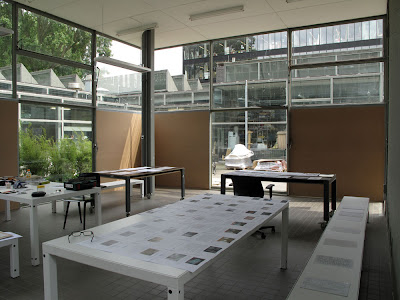
Labels:
invitation,
pavilion
Tuesday 25 May 2010
invitation

INVITATION
Surface Research Results Exhibition # 2
Monday May 31 2010 / 12:00 - 19:00 h
Tuesday June 1 2010 / 17:00 - 21:00 h
Wednesday June 2 2010 / 12:00 - 19:00 h
Thursday June 3 2010 / 9:00 - 14:00 h
Pavilion Gerrit Rietveld Academie
Fred Roeskestraat 96
1076 ED Amsterdam
Sincerely, Henri Jacobs.
Labels:
invitation
Thursday 20 May 2010
anxiety & anger, ugliness, etcetera

A quotation from Dario Gamboni's book "the destruction of art, iconoclasm and vandalism since the French revolution":
"(...) the essential link that modern psychologists have tended to establish between destructiveness and creativity has gained in modern art an imprecedented visibility and importance, in direct relation to its "iconoclasm". In the 1930's Picasso emphasized this dramatic change to Christian Zervos on the level of the modus operandum: "Previously, pictures advanced to their end by progression. Each day brought something new. A picture was a sum of additions. With me, a picture is a sum of destructions".
Labels:
destruction,
drawings,
picasso
Subscribe to:
Posts (Atom)


